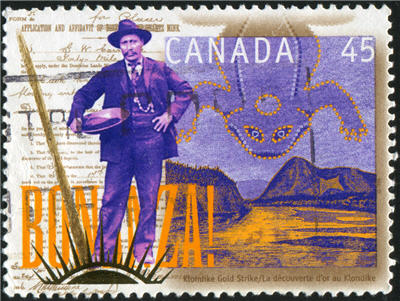Why the rush into Canadian gold mines may continue: Steve Todoruk

In the mining sector, mergers and acquisitions can deliver rapid returns to shareholders.
Investors in Cayden Resources saw their shares swell by 300% in price late last year, when Cayden received a takeover offer from Agnico Eagle Mines.
Steve Todoruk, a broker at Sprott Global Resource Investments Ltd., has been eyeing the next possible takeover. He believes he’s narrowed down the most likely targets.
In a recent note, he explains why it comes down to safety for the company making the acquisition:
I’m seeing two trends in mergers and acquisitions right now, as I look around the space for the next Cayden or the next Osisko Mining (which received a generous takeover early last year).
First off, in the last bull market, many big mining companies went after mines in higher-risk jurisdictions around the world. Today, investors are retrenching towards areas that are perceived as ‘safe’ – where governments aren’t likely to change the rules or confiscate assets. Investors are increasingly risk-averse and want exposure to mines in countries like Canada, the US, and Australia.
That’s why we’ve seen Eldorado Gold recently announce it was spinning off its Chinese assets, for instance.
The second trend we’re seeing is the strength of the US dollar relative to the Canadian dollar. If investors and mining CEOs believe this will last, then it will make sense for them to build mines in Canada. Their mining costs will be paid in Canadian dollars and they can sell their gold in US dollars. This could offer companies a bump to their bottom line, simply for building their mines in Canada.
In fact, the weak Canadian dollar is one of the few positive effects of poor resource markets. It’s a big break for mining companies that are trying to control costs now that their margins have contracted dramatically.
Investor preference for safe jurisdiction, coupled with a weak Canadian dollar, make Canadian mining assets especially appealing.
We’ve already seen a significant rush into Canadian assets as a result, besides the Osisko takeover. Goldcorp acquired Probe Mines in March, 20151 for their deposit located in Ontario, near an existing Goldcorp mine.
Soon after, Centerra Gold entered into an expensive joint venture agreement with Premier Gold Mines to develop its Hardrock gold deposit in eastern Canada.2 In April, Alamos Gold tied the knot with Aurico Gold through a merger in order to gain exposure to its Young Davidson Mine in eastern Canada.3
We’ve also just seen Yamana Gold announce a takeover of junior explorer Mega Precious Metals for their Monument Bay gold project in central Canada.4
As you can see, there’s a strong amount of interest in Canadian gold mines and deposits currently, and I believe it may continue.
There’s a short list of Canadian gold deposits and mines still on the market, which may look attractive to a major miner.
Based on my experience, majors will try to acquire medium-sized or large mines that will be able to produce at least 100,000 ounces of gold per year once they’re in operation.
As we saw in Goldcorp’s acquisition of Probe Mines, big miners also prefer to have mines that are close to their existing operations. This minimizes additional costs for new infrastructure or mine planning. Their labor force is already close by, and geologic conditions are likely to be similar, meaning they will have the right expertise in-house to develop the mine efficiently.
For mines that are further from where they are currently producing, an acquisition target will likely need to be larger and high-grade, with sufficient economics to warrant the strain and costs of extending out to a new area.
So which potential acquisition targets are left standing?
In my view, a short list of well-followed companies would include Detour Gold for its Detour Lake mine, Pretivm Resources for its large, high-grade Valley of the Kings deposit, Rubicon Minerals for its very near-production Phoenix gold mine, Richmont Mines with its Island Gold mine, Lakeshore Gold with its producing gold mines in the Timmins mining camp, Kirkland Lake with its producing mine in eastern Canada, and Kaminak Gold which owns the Coffee gold deposit in the Yukon.
Of course, we don’t know when a takeover could occur, and prices of these stocks could drop from here. Shareholders waiting for a takeover can often be left disappointed. If no takeover occurs, share prices can decline as investors lose interest, and a takeover can occur at a price that’s below where some investors purchased their shares.
Still, in my view the trend of mergers and acquisitions for control of Canadian assets will continue and more companies could receive bids, offering the possibility for attractive returns to shareholders in the midst of a bear market.
When a company gets taken over, it can deliver attractive returns to shareholders. We’ll be watching the companies on Steve’s short list for signs of interest from a major miner.
Steve’s short list does not constitute a recommendation.
P.S. Steve offers a complimentary, no-obligation portfolio review for your resource stocks. Call him at 800.477.7853 or e-mail him at stodoruk@sprottglobal.com.
1 Goldcorp Press Release. March 13, 2015. Goldcorp completes acquisition of Probe Mines Limited
2 Centerra Gold Press Release. February 05, 2015. Centerra Gold and Premier Gold to Jointly Advance the Trans-Canada Property
3 Alamos Gold Press Release. April 13, 2015. Alamos Gold and Aurico Gold to combine creating leading intermediate gold producer
4 Mega Precious Metals Press Release. April 24, 2015. Mega Precious Metals to be acquired by Yamana Gold
{{ commodity.name }}
{{ post.title }}
{{ post.date }}


Comments